skip to main |
skip to sidebar
This recipe was a sort of off-the-cuff, make-it-up-as-you-go-along creation – and it tasted really nice. It wasn’t so much sweet as it was hot, because I used a Scotch bonnet pepper, and hot is how I like things... but the sweetness was there, all the same.
And that, it would appear, is all I have to say about it. I've been trying to come up with some kind of spin to eke out this post, but I believe I've run out of imagination. I need a ghost-writer with a sense of humour and endless creativity. Any takers?
Recipe for: Hot-sweet vegetable curry
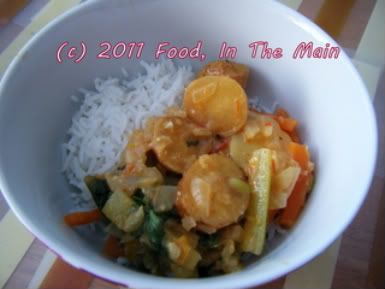 Ingredients:
1/2 cup fingerling or salad potatoes, sliced in 1cm rounds
1/2 cup ripe mango,cubed
1/2 cup tomatoes, chopped
1/4 cup green beans, sliced on the diagonal
1/4 cup carrots, sliced in thin sticks
1/4 cup bottlegourd, sliced in thin sticks
Ingredients:
1/2 cup fingerling or salad potatoes, sliced in 1cm rounds
1/2 cup ripe mango,cubed
1/2 cup tomatoes, chopped
1/4 cup green beans, sliced on the diagonal
1/4 cup carrots, sliced in thin sticks
1/4 cup bottlegourd, sliced in thin sticks
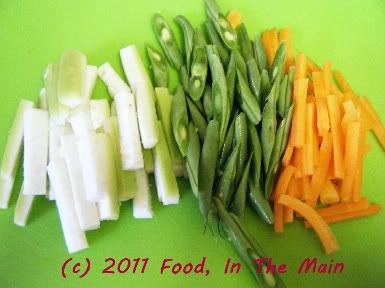 1/2 cup onions, chopped fine
1 cup milk
1/2 tsp cinnamon powder
1 tsp grated ginger
1/2 tsp Kitchen King masala (or your favourite garam masala)
Green chillies to taste
5-6 cashewnuts
2 tbsp oil
A generous handful of chopped coriander leaves for garnish
Method:
1. Toss the sliced potatoes with 1 tbsp oil and roast in the oven at 180C/350F, stirring them after 15 minutes, until they are golden and cooked - about 30 minutes or so. Reserve.
1/2 cup onions, chopped fine
1 cup milk
1/2 tsp cinnamon powder
1 tsp grated ginger
1/2 tsp Kitchen King masala (or your favourite garam masala)
Green chillies to taste
5-6 cashewnuts
2 tbsp oil
A generous handful of chopped coriander leaves for garnish
Method:
1. Toss the sliced potatoes with 1 tbsp oil and roast in the oven at 180C/350F, stirring them after 15 minutes, until they are golden and cooked - about 30 minutes or so. Reserve.
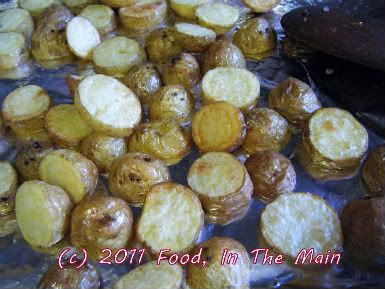 2. Heat 1/2 tbsp oil in a pan and add the ginger and cinnamon powder.
2. Heat 1/2 tbsp oil in a pan and add the ginger and cinnamon powder.
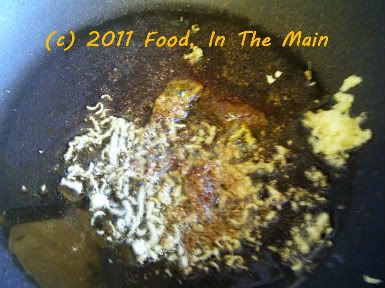 3. Add the chopped tomatoes and cook for 3-4 minutes, or till they start to break up.
3. Add the chopped tomatoes and cook for 3-4 minutes, or till they start to break up.
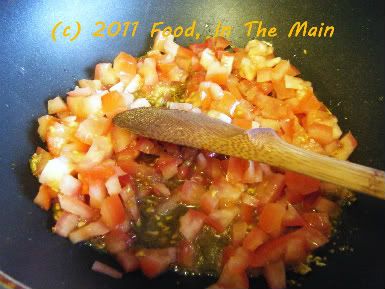 4. Add the chopped mangoes and the chillies, if using. Cook them on medium-high heat, stirring occasionally, until they become soft.
4. Add the chopped mangoes and the chillies, if using. Cook them on medium-high heat, stirring occasionally, until they become soft.
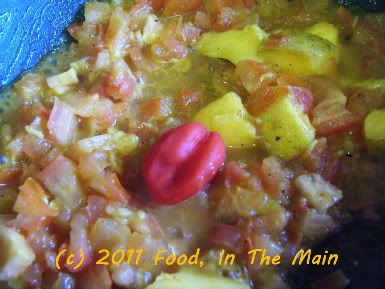 Remove from the heat and let the mixture cool.
Remove from the heat and let the mixture cool.
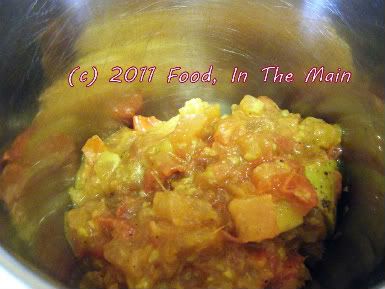 Once it's cool, puree along with the cashewnuts and reserve.
5. Now heat the remaining 1/2 tbsp oil and fry the chopped onions.
Once it's cool, puree along with the cashewnuts and reserve.
5. Now heat the remaining 1/2 tbsp oil and fry the chopped onions.
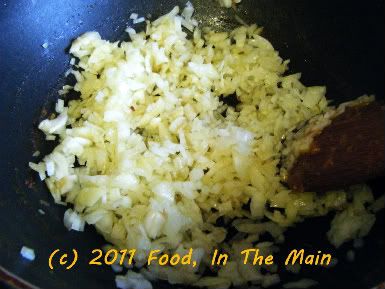 6. When the onions are soft and pale brown, add the sliced carrots, beans and bottlegourd.
6. When the onions are soft and pale brown, add the sliced carrots, beans and bottlegourd.
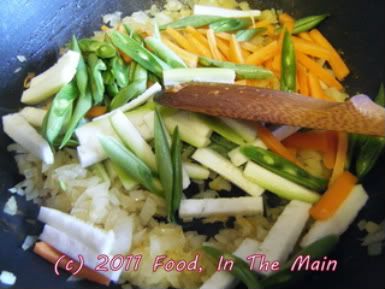 Add one cup water, cover the pan and let the vegetables cook till just done.
7. Stir in one cup milk and bring the mixture to a gentle boil on medium heat.
Add one cup water, cover the pan and let the vegetables cook till just done.
7. Stir in one cup milk and bring the mixture to a gentle boil on medium heat.
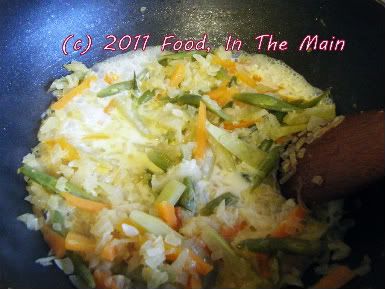 8. Add the pureed tomato-mango mixture and mix it in along with the Kitchen King masala powder..
8. Add the pureed tomato-mango mixture and mix it in along with the Kitchen King masala powder..
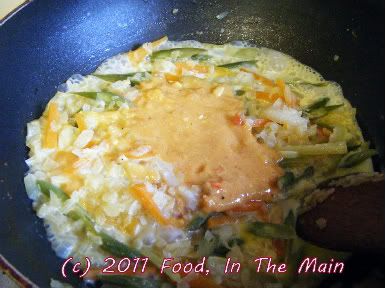 9. Bring to a gentle boil, then add the oven-fried potatoes and stir them in.
9. Bring to a gentle boil, then add the oven-fried potatoes and stir them in.
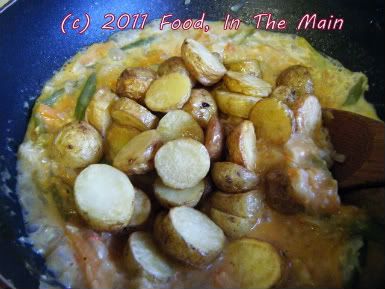 10. Let the curry simmer for 6-7 minutes on medium heat. I like the gravy to be fairly thick, but if you prefer it more runny, add water or milk as required and simmer for a few minutes longer. Add salt to taste. Then garnish with chopped coriander leaves and serve hot with steamed rice.
10. Let the curry simmer for 6-7 minutes on medium heat. I like the gravy to be fairly thick, but if you prefer it more runny, add water or milk as required and simmer for a few minutes longer. Add salt to taste. Then garnish with chopped coriander leaves and serve hot with steamed rice.
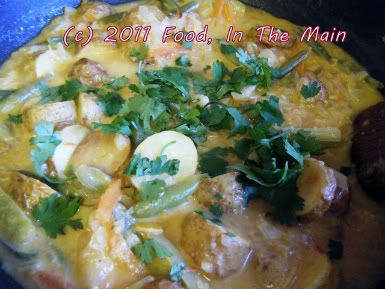 RECIPE: HOT-SWEET VEGETABLE CURRY
Ingredients:
1/2 cup fingerling or salad potatoes, sliced in 1cm rounds
1/2 cup ripe mango,cubed
1/2 cup tomatoes, chopped
1/4 cup green beans, sliced on the diagonal
1/4 cup carrots, sliced in thin sticks
1/4 cup bottlegourd, sliced in thin sticks
1/2 cup onions, chopped fine
1 cup milk
1/2 tsp cinnamon powder
1 tsp grated ginger
1/2 tsp Kitchen King masala (or your favourite garam masala)
Green chillies to taste
5-6 cashewnuts
2 tbsp oil
A generous handful of chopped coriander leaves for garnish
Method:
1. Toss the sliced potatoes with 1 tbsp oil and roast in the oven at 180C/350F, stirring them after 15 minutes, until they are golden and cooked - about 30 minutes or so. Reserve.
2. Heat 1/2 tbsp oil in a pan and add the ginger and cinnamon powder.
3. Add the chopped tomatoes and cook for 3-4 minutes, or till they start to break up.
4. Add the chopped mangoes and the chillies, if using. Cook them on medium-high heat, stirring occasionally, until they become soft.
Remove from the heat and let the mixture cool.
Once it's cool, puree along with the cashewnuts and reserve.
5. Now heat the remaining 1/2 tbsp oil and fry the chopped onions.
6. When the onions are soft and pale brown, add the sliced carrots, beans and bottlegourd.
Add one cup water, cover the pan and let the vegetables cook till just done.
7. Stir in one cup milk and bring the mixture to a gentle boil on medium heat.
8. Add the pureed tomato-mango mixture and mix it in along with the Kitchen King masala powder..
9. Bring to a gentle boil, then add the oven-fried potatoes and stir them in.
10. Let the curry simmer for 6-7 minutes on medium heat. I like the gravy to be fairly thick, but if you prefer it more runny, add water or milk as required and simmer for a few minutes longer.Add salt to taste. Then garnish with chopped coriander leaves and serve hot with steamed rice.
RECIPE: HOT-SWEET VEGETABLE CURRY
Ingredients:
1/2 cup fingerling or salad potatoes, sliced in 1cm rounds
1/2 cup ripe mango,cubed
1/2 cup tomatoes, chopped
1/4 cup green beans, sliced on the diagonal
1/4 cup carrots, sliced in thin sticks
1/4 cup bottlegourd, sliced in thin sticks
1/2 cup onions, chopped fine
1 cup milk
1/2 tsp cinnamon powder
1 tsp grated ginger
1/2 tsp Kitchen King masala (or your favourite garam masala)
Green chillies to taste
5-6 cashewnuts
2 tbsp oil
A generous handful of chopped coriander leaves for garnish
Method:
1. Toss the sliced potatoes with 1 tbsp oil and roast in the oven at 180C/350F, stirring them after 15 minutes, until they are golden and cooked - about 30 minutes or so. Reserve.
2. Heat 1/2 tbsp oil in a pan and add the ginger and cinnamon powder.
3. Add the chopped tomatoes and cook for 3-4 minutes, or till they start to break up.
4. Add the chopped mangoes and the chillies, if using. Cook them on medium-high heat, stirring occasionally, until they become soft.
Remove from the heat and let the mixture cool.
Once it's cool, puree along with the cashewnuts and reserve.
5. Now heat the remaining 1/2 tbsp oil and fry the chopped onions.
6. When the onions are soft and pale brown, add the sliced carrots, beans and bottlegourd.
Add one cup water, cover the pan and let the vegetables cook till just done.
7. Stir in one cup milk and bring the mixture to a gentle boil on medium heat.
8. Add the pureed tomato-mango mixture and mix it in along with the Kitchen King masala powder..
9. Bring to a gentle boil, then add the oven-fried potatoes and stir them in.
10. Let the curry simmer for 6-7 minutes on medium heat. I like the gravy to be fairly thick, but if you prefer it more runny, add water or milk as required and simmer for a few minutes longer.Add salt to taste. Then garnish with chopped coriander leaves and serve hot with steamed rice.
Ready, Steady, Cook used to be one of the cookery-cum-gameshow programmes that I watched with great enthusiasm in those far-off days when I was unemployed (on the insistence of the Home Office in the UK, I should add, and not because I was too lazy to work) and had lots of time on my hands. At that time I was unfamiliar with most British TV productions, actors, celebrities and shows – not to mention, show formats - so it was all new to me.
I still remember how horrified I was by Anne Robinson’s incredible rudeness to the participants on her quiz show, The Weakest Link, the first time I watched it. I couldn’t imagine anyone from other quiz shows I’d seen thus far – say, Mastermind UK, or Mastermind in India (with Siddharth Basu) – being so rude and getting away with it. And there didn’t seem to be any real reason for such personal attacks on what was meant to be a cerebral show. It took a while for me to realise that it was only a gimmick with Anne Robinson (ah, those days of innocence) and she was probably not as evil in real life... but the whole thing still took some getting over. Certainly, there was no way I could have faced that level of nastiness with the equanimity displayed by her victims, had I been a contestant.
Equally, I also still remember how instantly I was drawn to Ainsley Harriot’s goofy good looks, ebullient personality and permanent good cheer on Ready, Steady, Cook. The show format was also something I’d never seen before, and I was totally impressed by the amazing spur-of-the-moment decisions by the chefs on the show to make this recipe or that recipe based on what was in the bags they were given. Oh, for those days of innocence... I didn’t realise that it was all rehearsed and the chefs most likely knew what food items they were going to get from the contestants and, therefore, very likely also knew what they would be making with it.
This I discovered only during the application process for the show, when a very dear friend, Ammani (who’s way more enterprising, energetic, enthusiastic and extroverted than I could ever hope to be) persuaded me to apply to the show as a participant along with her. We had to fill out forms telling them about ourselves, our interests, our achievements thus far, and so on. I guess this was to see if we would be interesting enough for the show (and I really do feel that the reason we didn’t make the show was my exhaustive list of non-achievements. Had Ammani gone for a different partner, it would have been a cinch for them.)
Anyhow, along with our life stories, we also had to list the ingredients that we would be bringing along for the chefs, assuming we met the show’s criteria. A-ha! That was when the penny dropped for me - and that was when all the chefs that I collectively admired so much collectively cracked at their weak point and collectively toppled off their pedestals, leaving behind only their feet of clay. (Most of them eventually clambered back on, but the pedestals were only footstools and their feet remained clayey.)
But like I said, in the beginning it was all new to me, and I watched the chefs with a level of awe that they probably didn’t totally deserve, taken in by what I thought was unrehearsed improvisation, watching the recipes they made – and all in just 20 minutes cooking time! The level of energy was always high, given the time constraints, and Ainsley Harriot's presence made the show all the more lively.
Another thing I came to realise as I watched episode after episode was that the recipes weren’t really new, as such. Perhaps they differed a little in their list of ingredients (compared to the classic originals on which the chefs based their recipes), but that was all, and the differences only arose because of what they were given to work with. There were staple recipes from various cuisines – stir fries, bhajis, curries, casseroles, etc – which featured again and again.
I’m not complaining, really. It was just something that came as a slightly surprised realisation. For instance, the classic fish-and-chips, with salt and vinegar and mushy peas on the side, would be re-marketed by a chef as “posh fish and chips” on the show – maybe the chips would be sprinkled with rosemary, or instead of deep-fried chips they would have pan-fried potatoes, or add herbs to the mushy peas, etc and so on. And definitely the plating would be as showy as possible, to accentuate the difference between the regular stuff dished out by your corner chippie and the chef-cooked posh fish-and-chips.
And thus, gentle reader, I finally, finally come to the point of this post – my recipe today, which is for “posh” bread upma. It’s posh because I didn’t use ordinary bread... instead, I made use of some whole-wheat walnut pave loaf and some stone-baked boule which were left over from the previous day’s meal.
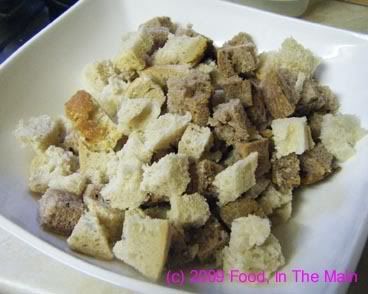
They did make a difference, because using good bread always makes a difference. You can make bread upma with ordinary sliced white bread from your local Tesco, and it will be edible - but as like as not, the bread will not hold its own against the rest of the masala that makes up this dish, simple though the masala is.
I know, I know... you’re probably wondering why this fuss over bread upma, a perfectly common dish that requires no specialty ingredients or cooking process – just stale leftover bread as the base. But bread upma is a really savoury, very delicious quick meal when you’re short of ingredients and time. You can make it as basic as you like or jazz it up – and mine is sort of poshed up. Seriously, though, the bread I used took on the flavour of the masala but didn’t itself turn to mush. It retained some bite and the small pieces of walnut only added to the upma's overall yumminess.
Stale bread is preferable for this dish, because of its firmer texture. But stale good quality bread is best, because it really makes this dish posh. In the style of Ready Steady Cook, anyway.
Recipe for: Posh bread upma
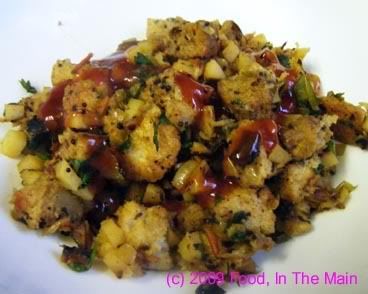
Ingredients:
4 cups stale good quality bread, cut into bite sized cubes (I used walnut bread and stone-baked crusty boule)
5-6 salad potatoes, chopped into small cubes
2 medium tomatoes, chopped
2 onions, chopped
1 small leek, chopped
5-6 fresh green chillies (or to taste), sliced into thin rings
3 tbsp yogurt (I used low-fat Greek yogurt)
1/2 tsp turmeric powder 1/4 tsp asafoetida powder (optional)
1 tsp mustard seeds
1 tsp cumin seeds
a few curry leaves
1 tbsp oil
Salt to taste 3-4 tbsp roughly chopped coriander leaves for garnish
Method:
1. Heat the oil in a wide-bottomed pan and add the green chillies, curry leaves, cumin seeds and turmeric powder and asafoetida and mustard seeds. Cover the pan and let the mustard seeds pop.
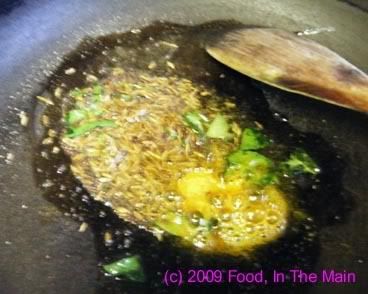
2. Add the chopped onions and leek next,
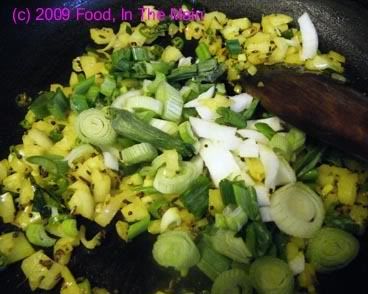
stir well and cook on a medium high flame till the onions soften and turn translucent and the leek has wilted.
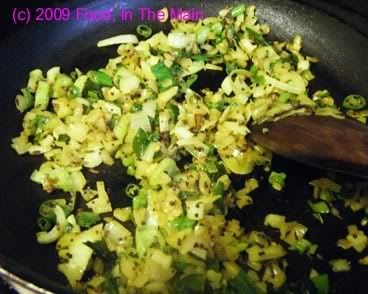
3. Now add the chopped tomatoes and cook till they soften and break down.
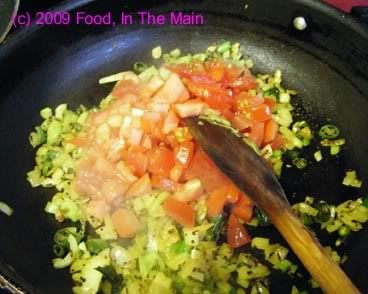
4. Next, add the cubed potatoes, stir well, cover and cook till the potatoes are done. Salad potatoes retain their shape even when cooked, but if you're using floury or mealy potatoes, make sure they dont break down completely.
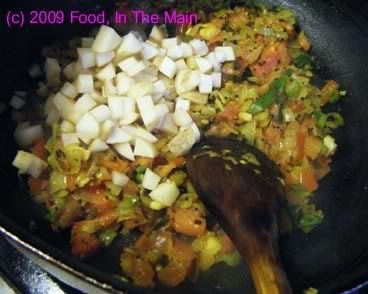
5. When the potatoes are cooked, stir in the yogurt. Turn the heat up and stir-fry for 2 minutes, till the moisture from the yogurt reduces.
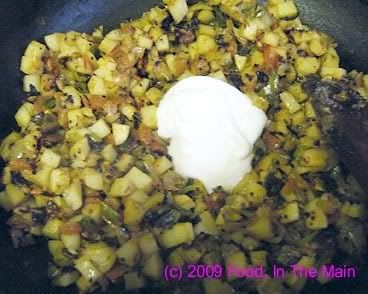
6. Add salt to taste and mix well. (Remember that the bread will have salt in it, so dont over-salt the masala). Add the bread now and mix carefully till the masala coats the bread evenly. 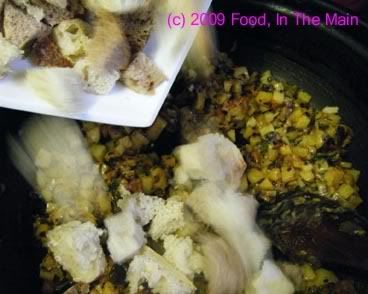
7. Turn the heat to medium-low and fry the bread with the masala till it starts to crisp up a little at the bottom.
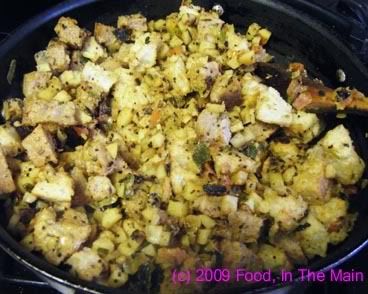 8. Sprinkle the coriander leaves, mix it all with a wide spatula and serve hot with tomato ketchup.
8. Sprinkle the coriander leaves, mix it all with a wide spatula and serve hot with tomato ketchup.
























